Earlier this year, NSF International introduced its new Global Animal Wellness Standards to address the full life cycle of all key species and establish best practices for how animals are kept, raised and responsibly managed. To comply with the new standards, operations must complete a hazard analysis as part of their animal wellness management system. Animal management practices and processes are so strongly connected that a change in one area could potentially affect another area. This article describes the process of utilizing a hazard analysis critical control point (HACCP) plan to identify, balance and mitigate key threats to animal wellness.
For primary producers, a HACCP plan formalizes what a good producer is doing and meets consumer demands regarding public health, animal health and welfare. Transporters can use a HACCP plan to measure and monitor the efficacy and performance of livestock handling and transport operations. For slaughter operations, a HACCP plan can make regular measurements at identified critical control points (CCPs) and closely monitor that tasks are performed correctly and consistently. At all levels of the supply chain, a HACCP plan is key to recognizing, avoiding and responding to critical risks.
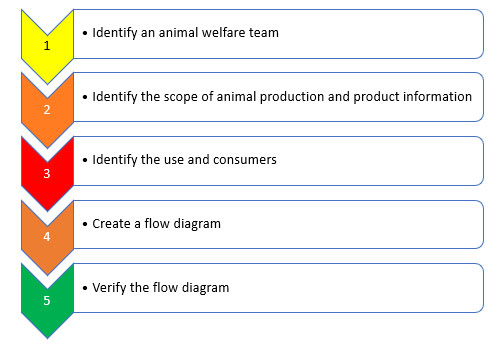
The five required steps of a hazard analysis (See Chart 1):
Identify the animal welfare HAACP team
Who is included may vary depending on the size and type of your operation, but assemble a team that is multidisciplinary and facility-based. You may want to consider including an animal welfare lead, veterinarian and field service technician, as well as sanitation, maintenance and QA staff.
Identify the scope of animal production and product information
Describe up front the scope of production that outlines:
- which species, life stage(s) and production type(s) of animals are under the responsibility of the operation;
- specific management claims (pasture-raised, grass-fed, cage-free, etc.);
- any specific regulatory, customer specifications or certification requirements that need to be met;
- which product is collected from the animals;
- the use and consumers are identified;
- the target market and intended use of the product are identified;
- a flow diagram.
The flow diagrams provide a schematic and systematic representation of all the steps of an operation’s production processes. It clearly and accurately details the sequence and interactions of steps and where inputs, outsourced processes and subcontracted work enter the flow. The flow diagram can then be used to identify points in the process where hazards may be introduced or are reasonably likely to occur and that require a preventive control measure. Consideration should also be given to steps preceding and following the specified operation.
Verify the flow diagram
The animal welfare team should conduct an on-site confirmation of the flow diagram to ensure it is accurate and complete. Utilize facility and property maps and compare the flow diagram to actual facility conditions. This step should confirm boundaries, buildings and fence lines as well as movement of animals, personnel, vehicles and other equipment to, within and off the property.
Apply the seven principles of HACCP
First, you must conduct a hazard analysis, and that starts with hazard identification: identify the known or reasonably foreseeable hazards relevant to the scope of the operation with the potential to cause an adverse effect on animal wellness. Relevant hazards will vary based on species, type of production, life stages of animals and point in protein supply chain.
Hazards may be identified when conducting the on-site confirmation of the flow diagrams, review of procedures, records, complaints and incident reports and through consultation with employees.
Identification considers hazards associated with:
- inputs;
- processes;
- facilities and equipment;
- and operational flow of animals/animal product.
Hazards can be categorized as biological, chemical or physical; however, when considering animal wellness, hazards typically include additional categories. Hazards can be described as “poor” or “undesired” outcomes:
- animal-based hazards are physiological and naturally occurring during the life cycles;
- design-based hazards are associated with buildings, equipment, facilities, etc.;
- managerial-based hazards can be directly tied to poor managements;
- environmental-based hazards can include local issues relating to climate, soil, weather patterns, etc.
The mechanisms and terminology used to categorize hazards can vary, but the list of hazards must be comprehensive (See Chart 2).
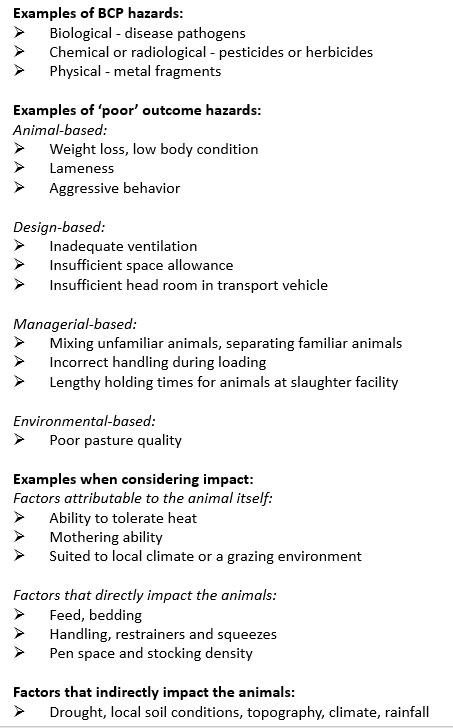
Once the hazards are identified, conduct and document a hazard assessment to determine whether each hazard’s elimination or reduction is essential to achieve animal wellness objectives.
Each hazard is evaluated according to the possible severity of adverse effects and the likelihood of their occurrence. A separate analysis may be required for each species and/or life stage of animals under the responsibility of the operation.
The assessment can utilize findings based on an operation’s past experience; illness, injury and mortality data; input from experts (e.g. veterinarians); scientific reports and other external information.
Finally, determine which hazards need to be controlled, the degree of control and which combination of preventive and control measures are required to effectively eliminate or minimize the identified hazards to acceptable levels. This generally includes the prerequisite programs and activities and will depend on the nature of operations to justify whether there is a need for a critical control point (CCP).
Identify the critical control points (CCPs) and points of particular attention (POPAs) in the production process required to reduce or eliminate the hazards/risks
A critical control point is a step in a process at which failure to control known hazards can lead to serious harm to people, animals or equipment (see Chart 3). These critical control points are likely to vary across operations because of differences in the production process and point in the supply chain.
CCPs should meet five criteria:
- be associated with the hazard of concern;
- be measurable and/or observable;
- have strict standards with tolerance limits;
- contain corrective measures in case of deviation.
Re-establish full control of the process once lost or bring risks down to an acceptable level
Identify points of particular attention (POPAs). These are conditions that could be threatening to animal health, animal welfare, public health or on-farm management, but where strict standards and critical limits have not been or cannot be defined. POPAs are generally influenced by many factors including biological variation among live animals, management choice and interactions between management practices.
Establish critical limits for critical control points and tolerance limits for POPA
Establish critical limits for each CCP and tolerances for each POPA that, when exceeded, will trigger the implementation of corrective and preventive measures.
A critical limit must consider established statutory and regulatory requirements, generally accepted industry thresholds, customer requirements and other relevant data and support the justification for selection of a critical limit.
For identified POPAs, since operations and producers will have unique management strategies and approaches, it is advisable to consider operation-specific tolerance thresholds as limits. When thresholds are not achieved, management is adjusted.
Establish monitoring requirements for CCPs and POPAs
This requires the operation to identify the what, how, how often and by whom.
Indicators (animal-based and resource-based) will be used to measure and assess that preventive and control measures are functioning appropriately. Indicators must utilize a scoring system that will be objective, consistent and repeatable by and between assessors.
These may include:
- animal assessments (body condition score, weight, vocalization, lameness, etc.);
- facility and equipment function assessments (water test results, pasture quality testing and feed testing; ventilation rates, air quality, lighting measure, etc.);
- operation assessments (frequency of use of animal handling aids, holding times before unloading animals, etc.).
Establish corrective measures when critical limits and tolerances are exceeded
Identify the planned corrections and corrective actions to be taken when critical limits are exceeded. The actions will ensure the cause is identified, the parameter controlled at the CCP or POPA is brought back under control, and that recurrence is prevented. Planned actions should consider any specific corrections and/or corrective measures to address the animals affected when a critical threshold is exceeded.
Establish procedures to verify the control measures
Indicate the verification activities for the control measures to ensure they are implemented, monitored and recorded as designed. These include verification of monitoring activities, taking appropriate corrective measures and record keeping.
Indicate the validation activities used to determine whether the control measures, when properly implemented, have effectively controlled the hazards. Validation can be accomplished by conducting facility studies, internal audits and program reviews and providing scientific literature citations.
Establish documentation and record keeping
Establish effective record-keeping procedures which document the HACCP program has been implemented. These should be appropriate to the nature and size of the operation.
Taking advantage of existing documentation (protocols, procedures, herd and flock health plans, etc.) and record formats (barn monitoring sheets, mortality and cull records, etc.) already in place can facilitate the development and smooth integration of HACCP-like approach. Modifying animal welfare-specific HACCP templates to suit a specific operation can result in a well-documented system.
Implementing a HACCP plan as described above not only helps you comply with new standards, but also to recognize and reduce major threats to animal wellness. NP
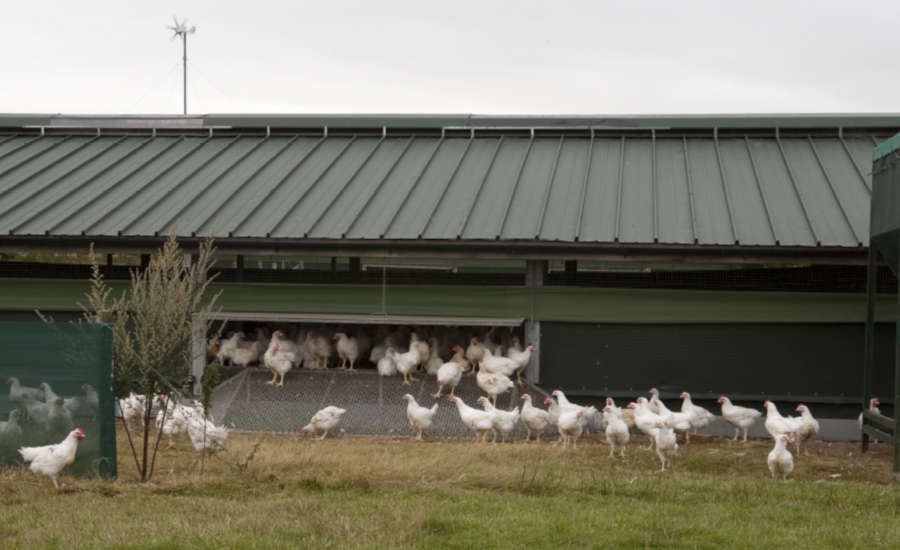

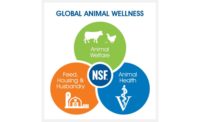

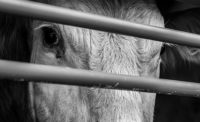
Report Abusive Comment